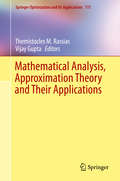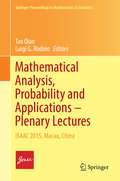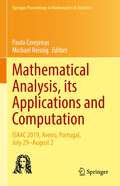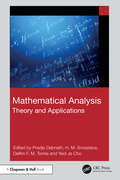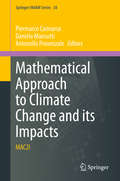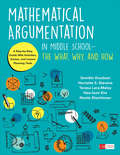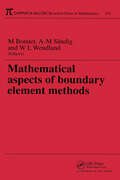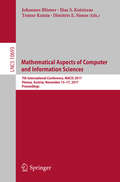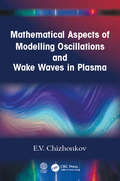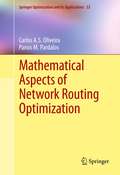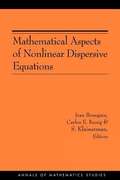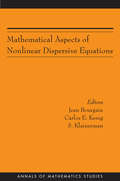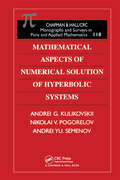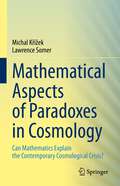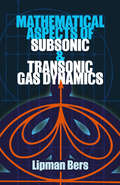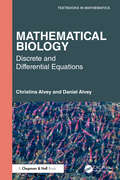- Table View
- List View
Mathematical Analysis, Approximation Theory and Their Applications
by Vijay Gupta Themistocles M. RassiasDesigned for graduate students, researchers, and engineers in mathematics, optimization, and economics, this self-contained volume presents theory, methods, and applications in mathematical analysis and approximation theory. Specific topics include: approximation of functions by linear positive operators with applications to computer aided geometric design, numerical analysis, optimization theory, and solutions of differential equations. Recent and significant developments in approximation theory, special functions and q-calculus along with their applications to mathematics, engineering, and social sciences are discussed and analyzed. Each chapter enriches the understanding of current research problems and theories in pure and applied research.
Mathematical Analysis, Probability and Applications – Plenary Lectures
by Tao Qian Luigi G. RodinoThis book collects lectures given by the plenary speakers at the 10th International ISAAC Congress, held in Macau, China in 2015. The contributions, authored by eminent specialists, present some of the most exciting recent developments in mathematical analysis, probability theory, and related applications. Topics include: partial differential equations in mathematical physics, Fourier analysis, probability and Brownian motion, numerical analysis, and reproducing kernels. The volume also presents a lecture on the visual exploration of complex functions using the domain coloring technique. Thanks to the accessible style used, readers only need a basic command of calculus.
Mathematical Analysis, its Applications and Computation: ISAAC 2019, Aveiro, Portugal, July 29–August 2 (Springer Proceedings in Mathematics & Statistics #385)
by Michael Reissig Paula CerejeirasThis volume includes the main contributions by the plenary speakers from the ISAAC congress held in Aveiro, Portugal, in 2019. It is the purpose of ISAAC to promote analysis, its applications, and its interaction with computation. Analysis is understood here in the broad sense of the word, including differential equations, integral equations, functional analysis, and function theory. With this objective, ISAAC organizes international Congresses for the presentation and discussion of research on analysis.The plenary lectures in the present volume, authored by eminent specialists, are devoted to some exciting recent developments in topics such as science data, interpolating and sampling theory, inverse problems, and harmonic analysis.
Mathematical Analysis: A Straightforward Approach
by K. G. BinmoreFor the second edition of this very successful text, Professor Binmore has written two chapters on analysis in vector spaces. The discussion extends to the notion of the derivative of a vector function as a matrix and the use of second derivatives in classifying stationary points. Some necessary concepts from linear algebra are included where appropriate. The first edition contained numerous worked examples and an ample collection of exercises for all of which solutions were provided at the end of the book. The second edition retains this feature but in addition offers a set of problems for which no solutions are given. Teachers may find this a helpful innovation.
Mathematical Analysis: Theory and Applications
by Pradip Debnath, H. M. Srivastava, Delfim F. M. Torres, and Yeol Je ChoMathematical Analysis: Theory and Applications provides an overview of the most up-to-date developments in the field, presenting original contributions and surveys from a spectrum of respected academics. Readers will discover numerous valuable tools and techniques to enhance their understanding of recent advancements in mathematical analysis and its applications. Each chapter highlights new research directions, making this book suitable for graduate students, faculty, and researchers with an active interest in the development of mathematical analysis and its practical implementation. Minimal prerequisites in analysis, topology, and functional analysis are required for readers to fully benefit from the content.Features Showcases the latest advancements in these areas by featuring contributions from distinguished scientists and mathematicians from around the world Suitable as a reference for postgraduate students and researchers Explores future research directions
Mathematical Approach to Climate Change and its Impacts: MAC2I (Springer INdAM Series #38)
by Piermarco Cannarsa Antonello Provenzale Daniela MansuttiThis book presents important recent applied mathematics research on environmental problems and impacts due to climate change. Although there are inherent difficulties in addressing phenomena that are part of such a complex system, exploration of the subject using mathematical modelling is especially suited to tackling poorly understood issues in the field. It is in this spirit that the book was conceived. It is an outcome of the International INDAM Workshop “Mathematical Approach to Climate Change Impacts – MAC2I”, held in Rome in March 2017. The workshop comprised four sessions, on Ecosystems, Hydrology, Glaciology, and Monitoring. The book includes peer-reviewed contributions on research issues discussed during each of these sessions or generated by collaborations among the specialists involved. Accurate parameter determination techniques are explained and innovative mathematical modelling approaches, presented. The book also provides useful material and mathematical problem-solving tools for doctoral programs dealing with the complexities of climate change.
Mathematical Argumentation in Middle School-The What, Why, and How: A Step-by-Step Guide With Activities, Games, and Lesson Planning Tools (Corwin Mathematics Series)
by Jennifer Knudsen Harriette Stevens Teresa Lara-Meloy Hee-Joon Kim Nikki ShechtmanGet them talking: Your formula for bringing math concepts to life! Want your middle schoolers to intelligently engage with mathematical ideas? Look no further. This research-based gem brings tough Standards for Mathematical Practice 3 standards for mathematical argumentation and critical reasoning alive—all within a thoroughly explained four-part model that covers generating cases, conjecturing, justifying, and concluding. Immediately engage students in fun, classroom-ready argumentation activities Help students explore—and take ownership of—mathematical ideas and concepts Promote precise use of mathematical language Includes games, vignettes, a rich companion website, sample tasks, and links to online tools. Bring well-planned, well-constructed mathematical discourse to life in your classroom today!
Mathematical Argumentation in Middle School-The What, Why, and How: A Step-by-Step Guide With Activities, Games, and Lesson Planning Tools (Corwin Mathematics Series)
by Jennifer Knudsen Harriette Stevens Teresa Lara-Meloy Hee-Joon Kim Nikki ShechtmanGet them talking: Your formula for bringing math concepts to life! Want your middle schoolers to intelligently engage with mathematical ideas? Look no further. This research-based gem brings tough Standards for Mathematical Practice 3 standards for mathematical argumentation and critical reasoning alive—all within a thoroughly explained four-part model that covers generating cases, conjecturing, justifying, and concluding. Immediately engage students in fun, classroom-ready argumentation activities Help students explore—and take ownership of—mathematical ideas and concepts Promote precise use of mathematical language Includes games, vignettes, a rich companion website, sample tasks, and links to online tools. Bring well-planned, well-constructed mathematical discourse to life in your classroom today!
Mathematical Aspects of Boundary Element Methods (Chapman & Hall/CRC Research Notes in Mathematics Series)
by Marc BonnetBoundary element methods relate to a wide range of engineering applications, including fluid flow, fracture analysis, geomechanics, elasticity, and heat transfer. Thus, new results in the field hold great importance not only to researchers in mathematics, but to applied mathematicians, physicists, and engineers. A two-day minisymposium Mathematical Aspects of Boundary Element Methods at the IABEM conference in May 1998 brought together top rate researchers from around the world, including Vladimir Maz’ya, to whom the conference was dedicated. Focusing on the mathematical and numerical analysis of boundary integral operators, this volume presents 25 papers contributed to the symposium. Mathematical Aspects of Boundary Element Methods provides up-to-date research results from the point of view of both mathematics and engineering. The authors detail new results, such as on nonsmooth boundaries, and new methods, including domain decomposition and parallelization, preconditioned iterative techniques, multipole expansions, higher order boundary elements, and approximate approximations. Together they illustrate the connections between the modeling of applied problems, the derivation and analysis of corresponding boundary integral equations, and their efficient numerical solutions.
Mathematical Aspects of Computer and Information Sciences
by Ilias S. Kotsireas Siegfried M. Rump Chee K. YapThis book constitutes the thoroughly refereedpost-conference proceedings of the 6th International Conference on MathematicalAspects of Computer and Information Sciences, MACIS 2015, held in Berlin,Germany, in November 2015. The 48 revised papers presented together with 7 invitedpapers were carefully reviewed and selected from numerous submissions. Thepapers are grouped in topical sections on curves and surfaces, appliedalgebraic geometry, cryptography, verified numerical computation, polynomialsystem solving, managing massive data, computational theory of differential anddifference equations, data and knowledge exploration, algorithm engineering ingeometric computing, real complexity: theory and practice, global optimization,and general session.
Mathematical Aspects of Computer and Information Sciences
by Ilias S. Kotsireas Johannes Blömer Temur Kutsia Dimitris E. SimosThis book constitutes the refereed proceedings of the 7th International Conference on Mathematical Aspects of Computer and Information Sciences, MACIS 2017, held in Vienna, Austria, in November 2017. The 28 revised papers and 8 short papers presented were carefully reviewed and selected from 67 submissions. The papers are organized in the following topical sections: foundation of algorithms in mathematics, engineering and scientific computation; combinatorics and codes in computer science; data modeling and analysis; and mathematical aspects of information security and cryptography.
Mathematical Aspects of Fluid Mechanics
by James C. Robinson José L. Rodrigo Witold SadowskiThe rigorous mathematical theory of the equations of fluid dynamics has been a focus of intense activity in recent years. This volume is the product of a workshop held at the University of Warwick to consolidate, survey and further advance the subject. The Navier–Stokes equations feature prominently: the reader will find new results concerning feedback stabilisation, stretching and folding, and decay in norm of solutions to these fundamental equations of fluid motion. Other topics covered include new models for turbulent energy cascade, existence and uniqueness results for complex fluids and certain interesting solutions of the SQG equation. The result is an accessible collection of survey articles and more traditional research papers that will serve both as a helpful overview for graduate students new to the area and as a useful resource for more established researchers.
Mathematical Aspects of Modelling Oscillations and Wake Waves in Plasma
by E. V. ChizhonkovThis book is devoted to research in the actual field of mathematical modeling in modern problems of plasma physics associated with vibrations and wake waves excited by a short high-power laser pulse. The author explores the hydrodynamic model of the wake wave in detail and from different points of view, within the framework of its regular propagation, a development suitable for accelerating electrons, and the final tipping effect resulting in unregulated energy transfer to plasma particles. Key selling features: Presents research directly related to the propagation of super-power short laser pulses (subject of the 2018 Nobel Prize in Physics). Presents mathematical modeling of plasma physics associated with vibrations and wake waves excited by a short high-power laser pulse. Includes studies of large-amplitude plasma oscillations. Most of the presented results are of original nature and have not appeared in the domestic and foreign scientific literature Written at a level accessible for researchers, academia, and engineers.
Mathematical Aspects of Network Routing Optimization
by Panos M. Pardalos Carlos A.S. OliveiraBefore the appearance of broadband links and wireless systems, networks have been used to connect people in new ways. Now, the modern world is connected through large-scale, computational networked systems such as the Internet. Because of the ever-advancing technology of networking, efficient algorithms have become increasingly necessary to solve some of the problems developing in this area. "Mathematical Aspects of Network Routing Optimization" focuses on computational issues arising from the process of optimizing network routes, such as quality of the resulting links and their reliability. Algorithms are a cornerstone for the understanding of the protocols underlying multicast routing. The main objective in the text is to derive efficient algorithms, with or without guarantee of approximation. Notes have been provided for basic topics such as graph theory and linear programming to assist those who are not fully acquainted with the mathematical topics presented throughout the book. "Mathematical Aspects of Network Routing Optimization" provides a thorough introduction to the subject of algorithms for network routing, and focuses especially on multicast and wireless ad hoc systems. This book is designed for graduate students, researchers, and professionals interested in understanding the algorithmic and mathematical ideas behind routing in computer networks. It is suitable for advanced undergraduate students, graduate students, and researchers in the area of network algorithms.
Mathematical Aspects of Nonlinear Dispersive Equations
by S. Klainerman Jean Bourgain Carlos E. KenigThis collection of new and original papers on mathematical aspects of nonlinear dispersive equations includes both expository and technical papers that reflect a number of recent advances in the field. The expository papers describe the state of the art and research directions. The technical papers concentrate on a specific problem and the related analysis and are addressed to active researchers. The book deals with many topics that have been the focus of intensive research and, in several cases, significant progress in recent years, including hyperbolic conservation laws, Schrödinger operators, nonlinear Schrödinger and wave equations, and the Euler and Navier-Stokes equations.
Mathematical Aspects of Nonlinear Dispersive Equations (Annals of Mathematics Studies #163)
by Jean Bourgain; Carlos E. Kenig & S. KlainermanThis collection of new and original papers on mathematical aspects of nonlinear dispersive equations includes both expository and technical papers that reflect a number of recent advances in the field. The expository papers describe the state of the art and research directions. The technical papers concentrate on a specific problem and the related analysis and are addressed to active researchers. The book deals with many topics that have been the focus of intensive research and, in several cases, significant progress in recent years, including hyperbolic conservation laws, Schrödinger operators, nonlinear Schrödinger and wave equations, and the Euler and Navier-Stokes equations.
Mathematical Aspects of Numerical Solution of Hyperbolic Systems (Monographs and Surveys in Pure and Applied Mathematics)
by A.G. Kulikovskii N.V. Pogorelov A. Yu. SemenovThis important new book sets forth a comprehensive description of various mathematical aspects of problems originating in numerical solution of hyperbolic systems of partial differential equations. The authors present the material in the context of the important mechanical applications of such systems, including the Euler equations of gas dynamics,
Mathematical Aspects of Paradoxes in Cosmology: Can Mathematics Explain the Contemporary Cosmological Crisis?
by Michal Křížek Lawrence SomerThis book provides a mathematical and numerical analysis of many problems which lead to paradoxes in contemporary cosmology, in particular, the existence of dark matter and dark energy. It is shown that these hypothetical quantities arise from excessive extrapolations of simple mathematical models to the whole physical universe. Written in a completely different style to most books on General Relativity and cosmology, the important results take the form of mathematical theorems with precise assumptions and statements. All theorems are followed by a corresponding proof, or an exact reference to the proof.Some nonstandard topics are also covered, including violation of the causality principle in Newtonian mechanics, a critical mathematical and numerical analysis of Mercury's perihelion shift, inapplicability of Einstein's equations to the classical two-body problem due to computational complexity, non-uniqueness of the notion of universe, the topology of the universe, various descriptions of a hypersphere, regular tessellations of hyperbolic spaces, local Hubble expansion of the universe, neglected gravitational redshift in the detection of gravitational waves, and the possible distribution of mass inside a black hole. The book also dispels some myths appearing in the theory of relativity and in contemporary cosmology. For example, although the hidden assumption that Einstein's equations provide a good description of the evolution of the whole universe is considered to be obvious, it is just a null hypothesis which has not been verified by any experiment, and has only been postulated by excessive extrapolations of many orders of magnitude.
Mathematical Aspects of Subsonic and Transonic Gas Dynamics
by Lipman BersThis concise volume by a prominent mathematician offers an important survey of mathematical aspects of the theory of compressible fluids. The treatment is geared toward advanced undergraduates and graduate students in physics, applied mathematics, and engineering. Focusing on two-dimensional steady potential flows, the text eschews detailed proofs in favor of clear indications of the main ideas and descriptions of new mathematical concepts and methods that arose in connection with these chapters in fluid dynamics.Starting with a general discussion of the differential equations of a compressible gas flow, the book advances to the mathematical background of subsonic flow theory. Subsequent chapters explore the behavior of a flow at infinity and methods for the determination of flows around profiles, flows in channels and with a free boundary, the mathematical background of transonic gas dynamics, and some problems in transonic flow. An extensive bibliography of 400 papers concludes the text.
Mathematical Biology: Discrete and Differential Equations (Textbooks in Mathematics)
by Christina Alvey Daniel AlveyThis text serves as an exploration of the beautiful topic of mathematical biology through the lens of discrete and differential equations. Intended for students who have completed differential and integral calculus, Mathematical Biology: Discrete and Differential Equations allows students to explore topics such as bifurcation diagrams, nullclines, discrete dynamics, and SIR models for disease spread, which are often reserved for more advanced undergraduate or graduate courses. These exciting topics are sprinkled throughout the book alongside the more typical first- and second-order linear differential equations and systems of linear differential equations.This class-tested text is written in a conversational, welcoming voice, which should help invite students along as they discover the magic of mathematical biology and both discrete and differential equations. A focus is placed on examples with solutions written out step by step, including computational steps, with the goal of being as easy as possible for students to independently follow along.Rich in applications, this book can be used for a semester-long course in either differential equations or mathematical biology. Alternatively, it can serve as a companion text for a two-semester sequence beginning with discrete-time systems, extending through a wide array of topics in differential equations, and culminating in systems, SIR models, and other applications.
Mathematical Book Histories: Printing, Provenance, and Practices of Reading (Trends in the History of Science)
by Ciarán Mac an Bhaird Philip BeeleyThis book both articulates and responds to increasing scholarly interest in the materiality of the book. Taking as its base the unique collection of mathematical books in the Russell Library at Maynooth, it addresses questions related to printing techniques and print culture, book production, provenance, and reading practices. It considers the histories of individual items of the Russell Collection, their previous locations and owners, and explores ways in which annotations, underlinings, hand-drawn diagrams, and the like reveal patterns of reading and usage. Finally, it seeks to elicit more information on a previously under-researched topic: the historical role of mathematics in the extensive network of Irish colleges that once covered Catholic Europe, located in places such as Salamanca, Rome, Douai, and Prague. Alongside delivering important new insights into print culture as a medium for transmitting scientific ideas, Mathematical Book Histories is thus also intended to contribute to a broader understanding of the role and significance of mathematics in the context of clerical instruction and more broadly in the academic tradition of Ireland up to the beginning of the twentieth century. Many of the volumes in the Russell Library reflect the remarkably rich book-trade that flourished in seventeenth and early eighteenth century Dublin and which was quite distinct from that in London. Booksellers often bought in their wares directly from abroad, with the result that publications could enter collections that did not enter the purview of contemporary English or Scottish scholars in Britain.
Mathematical Bridges
by Titu Andreescu Cristinel Mortici Marian TetivaBuilding bridges between classical results and contemporary nonstandard problems, this highly relevant work embraces important topics in analysis and algebra from a problem-solving perspective. The book is structured to assist the reader in formulating and proving conjectures, as well as devising solutions to important mathematical problems by making connections between various concepts and ideas from different areas of mathematics. Instructors and motivated mathematics students from high school juniors to college seniors will find the work a useful resource in calculus, linear and abstract algebra, analysis and differential equations. Students with an interest in mathematics competitions must have this book in their personal libraries.
Mathematical Challenges For All (Research in Mathematics Education)
by Roza LeikinThis book argues that mathematical challenge can be found at any level and at every age and constitutes an essential characteristic of any mathematics classroom aimed at developing the students’ mathematical knowledge and skills. Since each mathematics classroom is heterogeneous with respect to students’ mathematical potential, quality mathematical instruction results from matching the level of mathematical challenge to different students’ potential. Thus, effective integration of mathematical challenge in the instructional process is strongly connected to the equity principle of mathematics education. In the three sections in this volume readers can find diverse views on mathematical challenges in curriculum and instructional design, kinds and variation of mathematically challenging tasks and collections of mathematical problems. Evidence-based analysis is interwoven with theoretical positions expressed by the authors of the chapters. Cognitive, social and affective characteristics of challenging mathematical activities are observed and analyzed. The volume opens new avenues of research in mathematics education, and pose multiple questions about mathematical instruction rich in mathematical challenge for all. The authors invite readers to explore and enjoy mathematical challenges at different levels.
Mathematical Challenges from Theoretical/Computational Chemistry
by Committee on Mathematical Challenges from Computational ChemistryComputational methods are rapidly becoming major tools of theoretical, pharmaceutical, materials, and biological chemists. Accordingly, the mathematical models and numerical analysis that underlie these methods have an increasingly important and direct role to play in the progress of many areas of chemistry. This book explores the research interface between computational chemistry and the mathematical sciences. In language that is aimed at non-specialists, it documents some prominent examples of past successful cross-fertilizations between the fields and explores the mathematical research opportunities in a broad cross-section of chemical research frontiers. It also discusses cultural differences between the two fields and makes recommendations for overcoming those differences and generally promoting this interdisciplinary work.
Mathematical Challenges of Zero-Range Physics: Models, Methods, Rigorous Results, Open Problems (Springer INdAM Series #42)
by Alessandro MichelangeliSince long over the decades there has been a large transversal community of mathematicians grappling with the sophisticated challenges of the rigorous modelling and the spectral and scattering analysis of quantum systems of particles subject to an interaction so much localised to be considered with zero range. Such a community is experiencing fruitful and inspiring exchanges with experimental and theoretical physicists. This volume reflects such spirit, with a diverse range of original contributions by experts, presenting an up-to-date collection of most relevant results and challenging open problems. It has been conceived with the deliberate two-fold purpose of serving as an updated reference for recent results, mathematical tools, and the vast related literature on the one hand, and as a bridge towards several key open problems that will surely form the forthcoming research agenda in this field.
